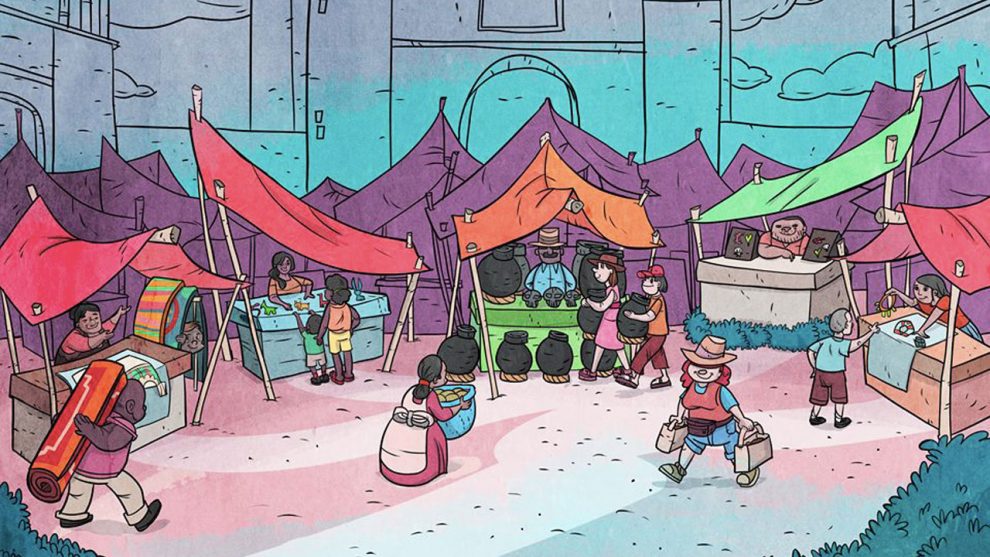Disclosure: Meeple Mountain received a free copy of this product in exchange for an honest, unbiased review. This review is not intended to be an endorsement.
Overview
Oaxaca, one of the 32 federative entities of Mexico, is well known for its handicrafts – pottery, textiles, woodcarvings, etc. Many families in this region dedicate their entire lives to perfecting their craft and, in the game of Oaxaca: Crafts of a Culture, each player takes on the role of one of these families as they prepare to sell their goods to passing tourists. Using dice, the players will obtain Handicraft cards which they will race to complete. The completed crafts are then sent to each player’s market stall where they will provide the player with unique benefits and abilities. At the end of the game, the player who has the most valuable collection of crafts in their stall will win the game.
Contents
Oaxaca comes with 4 meeples in different colors, 4 player boards, 20 dice, 60 wooden craft cubes, and a whole mess of cards. These cards are divided into several types – Handicraft cards, Tourist cards, Banner cards, Reference cards, and a Start Player card. The Handicraft cards are further divided into several kinds – Woodcarving, Jewelry, Pottery, Textile, and Tin. Each of these different types corresponds to one face of the die. This is how the player will determine which cards they can interact with on their turns. There is also a detailed and very well written rule book.
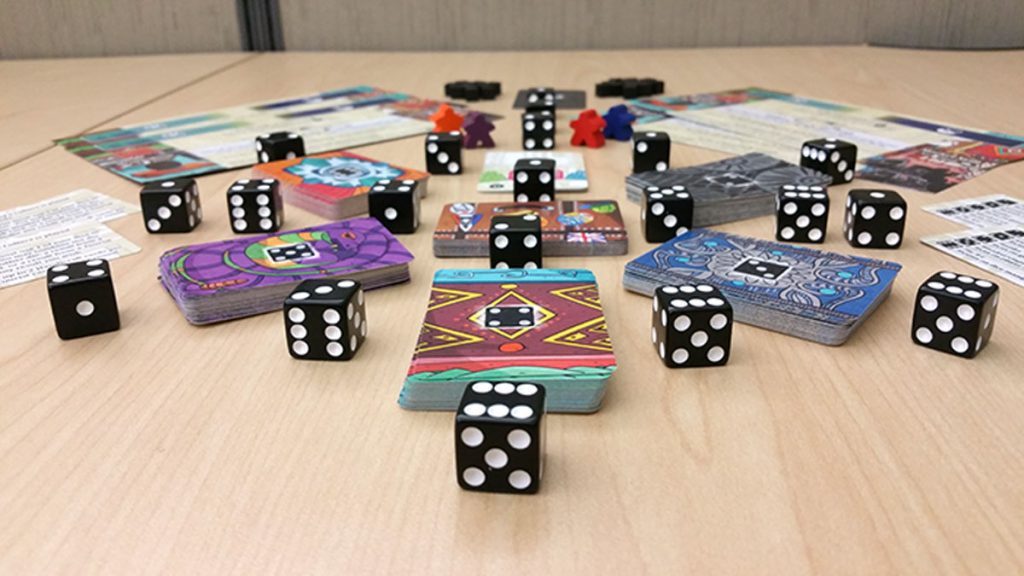
While I cannot comment on the overall quality of the final product, I can comment on the artwork that was provided. Derek Bacon has worked with Undine Studios on several of their past projects and his work there was stellar. The story is no different this time around. The artwork for this game is fantastic. The colors are bold and vivid and the artwork definitely makes me think of a south-of-the-border open air marketplace.
Setup
At the beginning of the game, the five different Handicraft decks are shuffled together and placed face down in a row. The Tourist deck is shuffled and 6 cards are drawn from this deck and placed face up beneath the Handicraft decks in a 2 x 3 grid. The rest of the Tourist deck is placed next to this with room for a discard pile. One Craft cube is placed between the two cards in the leftmost column. The other Craft cubes are placed nearby to form a supply. The players then receive a player mat, a meeple, a Banner card, and 5 dice each. The Banner card is placed into the player’s Market Stall area. Finally a starting player is randomly selected and you are ready to begin.
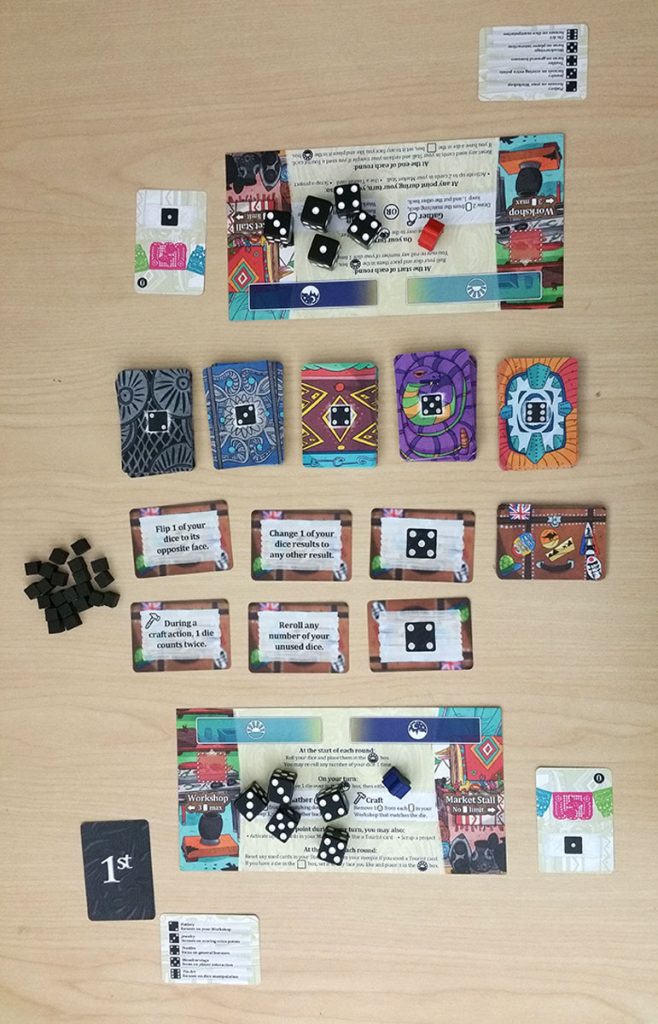
Anatomy of a Round
Each player will begin the round by rolling all of their dice and then placing the dice in the Daytime area of their player board. Then, beginning with the start player, they will go around the table taking turns and performing one action at a time. There are two basic actions to choose from and several free actions.
The basic actions will allow you to draw cards from the various decks to add to your workshop or to craft wares. Each card comes into play with a number of Craft cubes on it (3 to 5 per card). Your dice can be used to remove cubes from these cards. Whenever the last cube is removed from a card, the card is moved to your Market Stall where its benefit becomes available to be taken advantage of. The free actions allow players to interact with the Tourist cards, set aside a die for use on a future turn, activate cards in the Market Stall, get rid of unwanted projects, or combine any two dice to obtain a desired result.
As each die is used, it is moved to the Nightfall area of the player board. Once a player has used all of their dice, they are finished with the round. Once all players have completed their actions for the round, the Tourist card marker moves one column to the right and a new round begins.

The Cards
The Handicraft cards have multiple things in common. Each card is associated with a die face. The back side of the card features a unique illustration with the die face presented very prominently. Flipping the card over, the same die face resides in the upper left hand corner of the card. To the right of this, in the other corner, is a number which specifies how many craft cubes the card comes into play with. At the bottom of the card is an area of text which describes what the card does. These abilities are varied in nature. Some allow you to manipulate your dice. Some provide you with free, virtual dice for your turn. Others provide other benefits such as end game bonuses. In the middle of each of these cards is an illustration of the Handicraft that the card represents.

The tourist cards feature an illustration that resembles the luggage of a well-seasoned traveler replete with stickers and labels from many different countries. The flipside of these cards provides a textual area which describes what benefits the card provides if a player chooses to interact with it during one of their turns. These can provide many of the same types of benefits that the Handicraft cards would provide the players with once they are moved to the player’s Market Stall as well as a few benefits that are unique to the Tourist cards only.
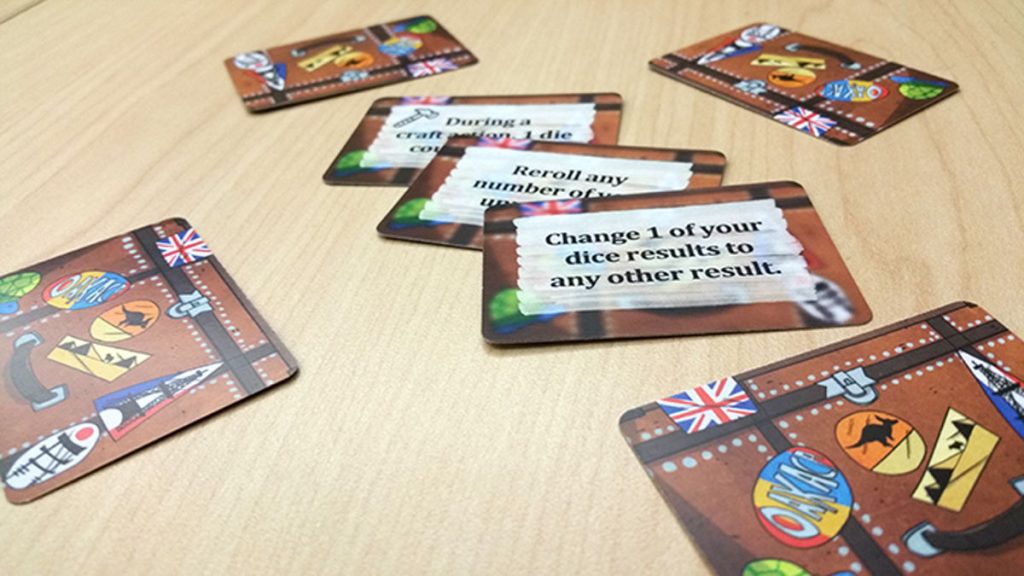
The Start Player and Reference cards are self-explanatory. The final card is the Banner card. Each player begins the game with one of these and they act as wildcards. Using the ability of this card will allow the player to either draw a single card from any of the decks and add it to their workshop OR remove a single craft cube from any of the projects that are already in their workshop area.
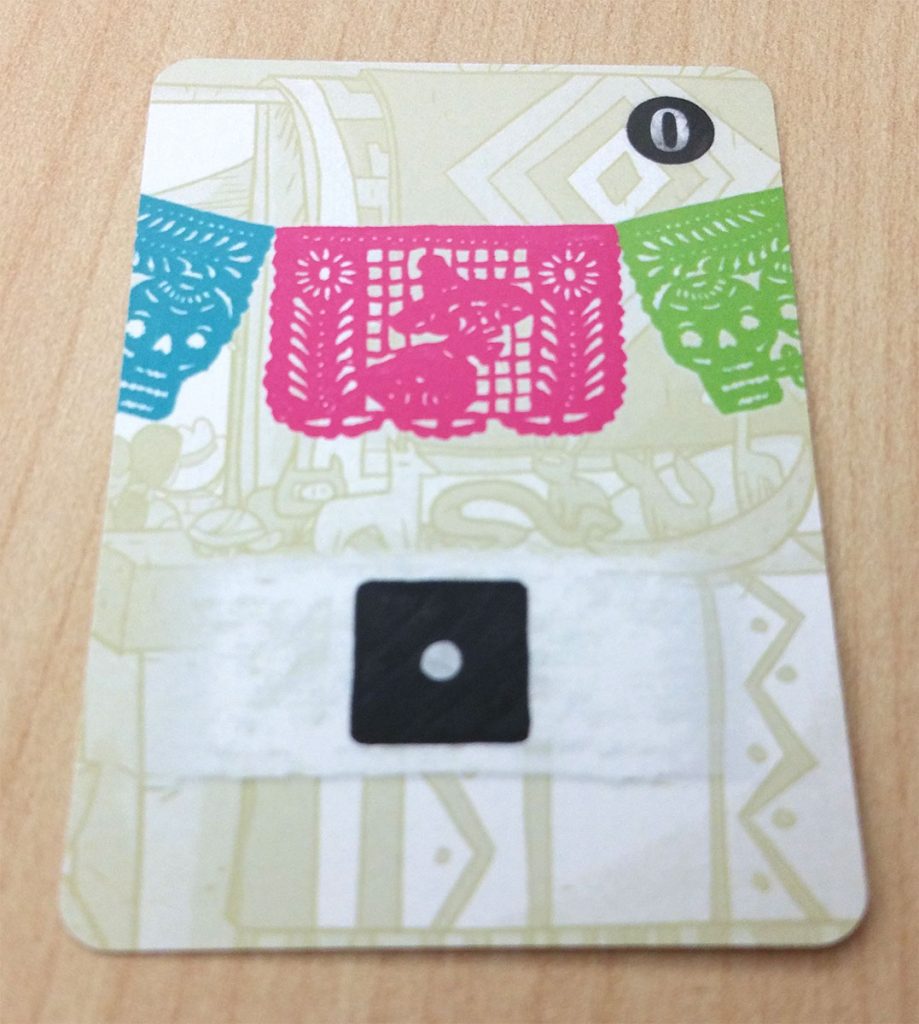
End Game & Scoring
The game comes to an end after the third round. At that point, each player will earn 2 points for each card that is still in their workshop. Each card in their Market Stall provides points equal to its value (the number in the upper right-hand corner). The players also earn any bonus points that their cards may have provided and the player with the highest total wins.
Thoughts
There’s a lot to like about Oaxaca: Crafts of a Culture. For starters, as I mentioned earlier, it’s just a good looking game. The artwork is bold and vivacious and inviting. It just draws you in as a player. Each new card that gets turned up reveals a new surprise and it’s always a pleasure to behold. But, we don’t play games just because they look pretty, do we? Right now, you may be wondering how the game actually plays and whether it’s worth your time and your money. While I can’t tell you how to spend your money, I can tell you confidently, that Oaxaca is definitely worth your time.
While Oaxaca’s not the most brain-burning game out there, it does still present you with an interesting puzzle. Since there are only three rounds of play, you’re going to be tasked with trying to crank out as many crafts during those turns as you can. This requires a little bit of planning and strategizing. Buying this card, then using the Tourist card, and using that card’s ability in your Market Stall will allow you to remove a couple of cubes from that card over there and then you can claim that card as well. But wait, if you’re removing two cubes from one card, why not two cards? Maybe you should expend a die to draw a second card from the same deck… and on and on it goes.
Oaxaca is a game not so much about engine building as it is about combo building. And it feels pretty darned good when you’re able to pull off a clever chain of combos and claim three or four cards in the process.
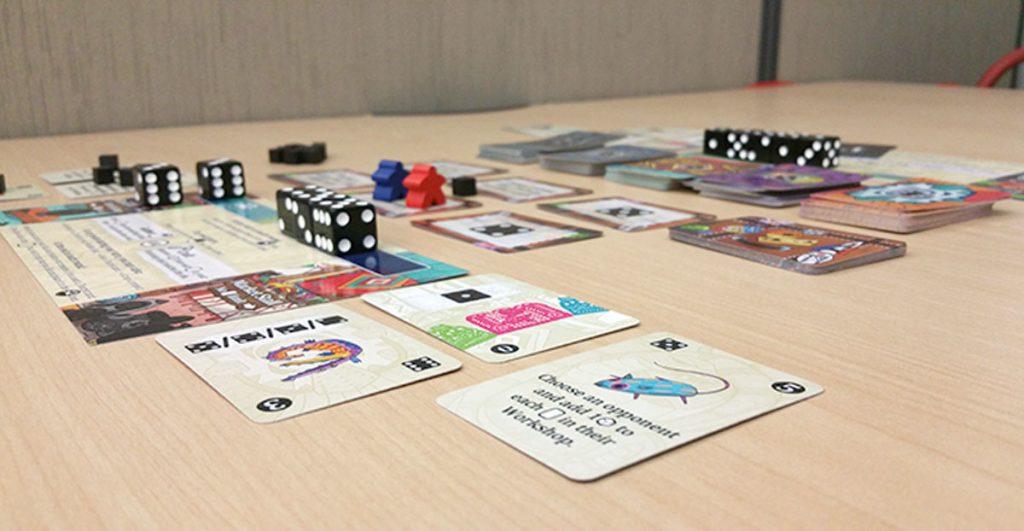
There is one checkmark in the negative column, though. You might be tempted to think it’s the dice. Dice rolling, by its very nature, introduces randomness into the game and a lot of people (myself included) tend to turn a blind eye to any game with a lot of randomness in it. However, Oaxaca provides enough ways to manipulate the dice and add to your dice rolls that the randomness factor here is pretty well mitigated. I never feel like the game is in control of what happens to me while I am playing. So, no, the dice are not the negative element that I am thinking of.
My biggest gripe about Oaxaca: Crafts of a Culture (and it’s not much of one) is that it’s pretty short. It feels like just when you’re starting to get a good head of steam on you, the game comes to an end. While the brief time window is the main thing that builds the tension in the game and drives it along, it’s still a bit disheartening nonetheless. I spoke to the game’s developer, Ben Haskett, about why the game is so short and this is what he had to say:
“The game actually started off with five rounds, believe it or not, and we play-tested at that length for over a year. In the end, t’was analysis paralysis that killed the fifth–by the start of the fifth round, players had so many Handicraft cards in their Market Stalls that they had difficulties choosing which to activate on their turns. As a result, the fifth round took about as long as the third and fourth rounds combined. The fourth round was later axed for much the same reason (though not as dramatic), and that left us at the three rounds we have today. We feel it’s better to leave players wanting more (at a solid 30-40 minutes) rather than have the game overstay its welcome.
The good news, though, is that the game can easily accommodate a fourth round–all you have to do is lay out two more Tourist cards, and then you and your friends are good to go. So for players looking for a longer experience where you can really flex the muscle you’ve built up in your Market Stall, a fourth round might be in the cards for you.”
So, I guess that explains that. If the developer tells me they’re trying to keep the experience fun for me, then I really can’t gripe about that too much. And it is fun. There’s no denying that. Each time that I’ve sat down to play a game, I’ve had a pretty good time. I think you will, too. Go ahead. Give Oaxaca: Crafts of a Culture a try. You’ve got my permission.
What do you think about Oaxaca: Crafts of a Culture? Have you ever been to Oaxaca? Tell us your story or your thoughts in the comments below!


